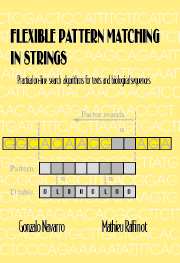 Flexible Pattern Matching in Strings
Flexible Pattern Matching in Strings 1 - Introduction
Published online by Cambridge University Press: 18 December 2014
Summary
Why this book? Our aim and focus
String matching can be understood as the problem of finding a pattern with some property within a given sequence of symbols. The simplest case is that of finding a given string inside the sequence.
This is one of the oldest and most pervasive problems in computer science. Applications requiring some form of string matching can be found virtually everywhere. However, recent years have witnessed a dramatic increase in interest in string matching problems, especially within the rapidly growing communities of information retrieval and computational biology.
Not only are these communities facing a drastic increase in the text sizes they have to manage, but they are demanding more and more sophisticated searches. The patterns of interest are not just simple strings but also include wild cards, gaps, and regular expressions. The definition of a match may also permit slight differences between the pattern and its occurrence in the text. This is called “approximate matching” and is especially interesting in text retrieval and computational biology.
The problems arising in this field can be addressed from different view-points. In particular, string matching is well known for being amenable to approaches that range from the extremely theoretical to the extremely practical. The theoretical solutions have given rise to important algorithmic achievements, but they are rarely useful in practice: A well-known fact in the community is that simpler ideas work better in practice. Two typical examples are the famous Knuth-Morris-Pratt algorithm, which in practice is twice as slow as the brute force approach, and the well-known Boyer-Moore family, whose most successful members in practice are highly simplified variants of the original proposal.
It is hard, however, to find the simpler ideas in the literature. In most current books on text algorithms, the string matching part covers only the classic theoretical algorithms. There are three reasons for that.
- Type
- Chapter
- Information
- Flexible Pattern Matching in StringsPractical On-Line Search Algorithms for Texts and Biological Sequences, pp. 1 - 14Publisher: Cambridge University PressPrint publication year: 2002


